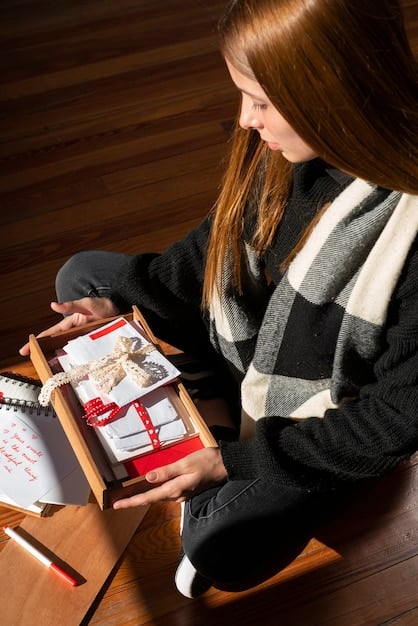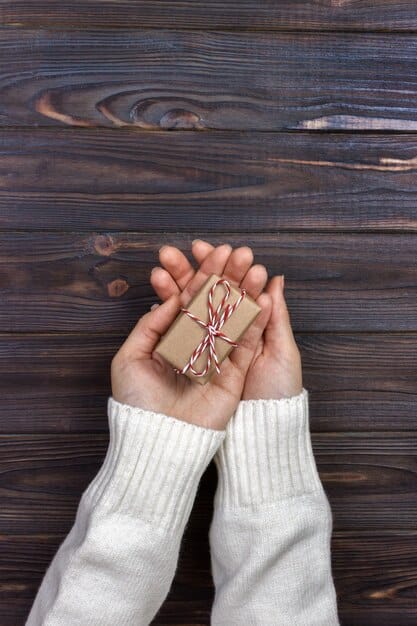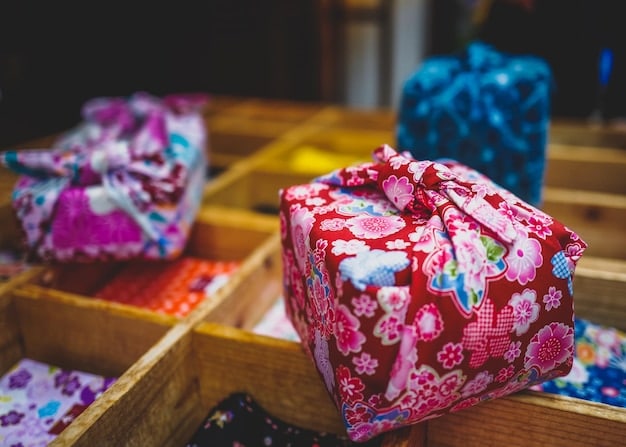Decoding Japanese Gift-Giving: A 2025 Guide for US Travelers

Decoding Japanese gift-giving customs is essential for US travelers to avoid social faux pas in 2025, ensuring respectful and meaningful interactions through understanding cultural nuances like appropriate occasions, gift types, and presentation techniques.
Navigating the intricate world of Japanese gift-giving can be daunting for US travelers. Understanding these traditions is crucial to avoid cultural missteps and show genuine respect. This 2025 guide will help you decode Japanese gift-giving customs and ensure your gestures are well-received.
The Significance of Gift-Giving in Japanese Culture
Gift-giving, or “okurimono,” is a deeply ingrained aspect of Japanese culture, representing more than just a simple exchange of presents. It signifies relationships, respect, and social harmony. Understanding these nuances is vital for US travelers to navigate Japanese society with grace and sensitivity.
Why Gift-Giving Matters
In Japan, gift-giving strengthens bonds and maintains social equilibrium. It’s a way to express gratitude, acknowledge obligations, and foster goodwill. The act itself, along with the presentation, holds significant weight.
The Concept of Reciprocity
The principle of reciprocity is central to Japanese gift-giving. Receiving a gift often implies a future obligation to reciprocate, although not necessarily with something of equal value. The thought and effort behind the gift are what truly count.
- Expressing Gratitude: Gifts are often given to show appreciation for hospitality or assistance.
- Maintaining Relationships: Gift-giving can solidify personal and professional bonds.
- Social Obligations: Certain occasions require gift-giving as a matter of course.
Japanese gift-giving is more about the gesture and the relationship than the material value of the gift. The customs and traditions surrounding it are deeply rooted in the culture, making it essential for visitors to understand and respect them.

Occasions for Gift-Giving: When to Present a Gift
Knowing when to give a gift in Japan is just as important as knowing what to give. Certain occasions are traditionally associated with gift-giving, and being aware of these will help you avoid cultural missteps. From seasonal greetings to personal milestones, understanding these moments is key.
Oseibo and Ochugen: Year-End and Mid-Year Gifts
Oseibo (year-end gifts) and Ochugen (mid-year gifts) are significant occasions for expressing gratitude to those who have supported you throughout the year. These gifts are typically given to superiors, colleagues, or service providers.
Personal Occasions: Birthdays and Weddings
While birthdays aren’t as emphasized in Japan as in the US, weddings are definitely occasions where gifts are expected. Monetary gifts in special envelopes (shugi-bukuro) are customary.
- Housewarming: When invited to someone’s new home, bringing a small gift is customary.
- Visiting Someone’s Home: It’s polite to bring a small offering, such as sweets or fruit.
- Apologies: Gifts can be used to express remorse and seek forgiveness.
Understanding the right occasions for gift-giving ensures that your gestures are appropriate and appreciated. Paying attention to these cultural cues demonstrates respect and consideration for Japanese customs.
Choosing the Right Gift: What to Give (and Avoid)
Selecting the perfect gift involves more than just finding something appealing. It requires understanding Japanese sensibilities and avoiding items that may be considered unlucky or inappropriate. The choice of gift can significantly impact how your gesture is perceived.
Consider the Recipient
Think about the recipient’s preferences, age, and social status. A gift that is well-suited to the individual demonstrates thoughtfulness and consideration.
Lucky and Unlucky Gifts
Certain numbers and items are considered unlucky in Japanese culture. Avoid giving sets of four (related to death) or sharp objects (symbolizing cutting ties). Green tea is usually offered to those visiting a grave so giving it as a gift can be considered rude.
- Food Items: Sweets, fruits, and local specialties are generally safe and appreciated.
- Handmade Gifts: Showing personal effort can be a thoughtful gesture.
- Gift Certificates: These are becoming more common, but consider the recipient’s preferences.
Choosing the right gift shows respect for cultural sensitivities and ensures your gesture is well-received. Avoidance of potentially unlucky items is just as important as selecting something appropriate.
The Art of Wrapping and Presentation
In Japan, the presentation of a gift is often as important as the gift itself. The art of wrapping, known as “furoshiki,” adds an extra layer of thoughtfulness and respect. The way you present the gift can elevate its significance.
Furoshiki: Traditional Wrapping Cloth
Using a furoshiki, a traditional wrapping cloth, adds elegance and cultural flair to your gift presentation. Learning a few basic wrapping techniques can impress your hosts.
The Importance of Neatness
Regardless of the wrapping method, neatness and attention to detail are crucial. A well-wrapped gift shows respect and consideration for the recipient.
- Avoid Bright Colors: Subdued and elegant colors are generally preferred.
- Use Quality Paper: The wrapping paper should be of good quality and free of tears.
- Present with Both Hands: This gesture shows respect when handing over the gift.
Presentation is key in Japanese gift-giving. Paying attention to the wrapping and manner of presentation elevates the act of giving and shows deep respect for the recipient.

Giving and Receiving: Etiquette and Customs
The act of giving and receiving gifts in Japan comes with its own set of customs and etiquette. Knowing how to properly offer and accept a gift will help you navigate these social interactions with grace.
How to Offer a Gift
When presenting a gift, offer it with both hands and a slight bow. A humble phrase, such as “Trivial but please accept this,” acknowledges the gift’s relative insignificance.
How to Receive a Gift
Accept the gift with both hands, expressing gratitude. It’s customary to decline the gift once or twice before accepting, to avoid appearing greedy.
- Avoid Opening in Front of the Giver: Unless explicitly encouraged, refrain from opening the gift immediately.
- Express Appreciation: After receiving the gift, be sure to thank the giver sincerely.
- Reciprocity: Be prepared to reciprocate in the future, if appropriate.
Mastering the etiquette of giving and receiving reinforces the respect and thoughtfulness behind the gift. These customs enhance social harmony and strengthen relationships.
Navigating Common Gift-Giving Scenarios in 2025
As Japan continues to evolve, some gift-giving customs are adapting to modern times. Understanding common scenarios and how to navigate them will help US travelers in 2025 avoid any potential social faux pas.
Business Settings
In business settings, gift-giving can be a sensitive issue. Ensure your gifts are appropriate for the situation and avoid anything that could be perceived as a bribe.
Family Gatherings
When visiting a Japanese family, bringing a small gift for the hosts is always appreciated. Regional specialties or artisanal products can be good choices.
- Home Stays: If staying with a Japanese family, a thoughtful gift for each member is appropriate.
- Cultural Exchange: Engaging in conversation about the gift can enhance mutual understanding.
- Modern Trends: While traditions remain important, younger generations may appreciate more contemporary gifts.
Adapting to modern trends while respecting traditional customs ensures that your gift-giving is both appropriate and appreciated. Staying informed about evolving social norms is essential for US travelers.
| Key Point | Brief Description |
|---|---|
| 🎁 Occasions | Know when to give, like Oseibo or housewarming. |
| 🍀 Lucky & Unlucky | Avoid sets of four and sharp items. Opt for sweets or fruits. |
| 🎀 Presentation | Use furoshiki and present with care, showing respect. |
| 🤝 Receiving | Accept with both hands, express gratitude, and avoid opening immediately. |
Frequently Asked Questions
▼
Gift-giving in Japan is a vital part of social interaction, representing respect, gratitude, and the strengthening of relationships. It’s often more about the gesture and presentation than the value of the gift itself.
▼
The two main gift-giving seasons are Oseibo (year-end) and Ochugen (mid-year). These are times to show appreciation to those who have supported you throughout the year, typically superiors and colleagues.
▼
Avoid giving sets of four, as the number is associated with death. Sharp objects, which can symbolize cutting ties, and green tea, often offered at funerals, should also be avoided.
▼
Offer the gift with both hands and a slight bow. Use a humble phrase, like “Trivial but please accept this.” Ensure the gift is neatly wrapped, preferably using traditional furoshiki.
▼
Unless explicitly encouraged, it’s generally considered polite to refrain from opening a gift in front of the giver. Express your appreciation and wait until later to open it.
Conclusion
Understanding and embracing Japanese gift-giving customs can significantly enhance your travel experience in 2025. By paying attention to the occasions, selecting appropriate gifts, mastering the art of presentation, and observing proper etiquette, US travelers can avoid social faux pas and foster deeper connections with the people they meet.





